Want to discover how to engage more users on Twitter?
Have you considered using psychology techniques?
Using some psychology tips in your tweets can make your Twitter feed more interesting and your followers will be more likely to engage with you.
In this article I'll share six psychology tips you can use to create tweets that'll engage your audience.
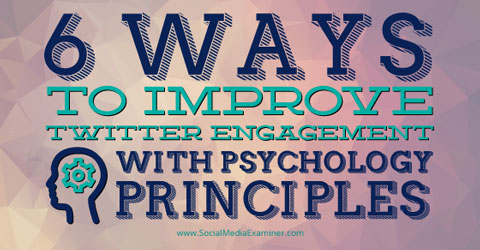
Listen to this article:
Where to subscribe: Apple Podcasts | Spotify | YouTube Music | YouTube | Amazon Music | RSS
You can also subscribe via RSS, Stitcher and iTunes. How to subscribe/review on iPhone.
Why?
The methods used to construct language and motivate customers often stem back to basic psychology, which is something used to persuade, engage and influence buyers.
For example, using rhetorical questions at the start of Twitter ads or general “sales” tweets might work well for you. The tweets will engage users and make them consider how your product or service could benefit them.
Here's how you can improve brand recognition, catch the attention of more users and increase the number of clicks, retweets and favorites that your tweets receive.
#1: Take Advantage of the Bandwagon Effect
Humans are innately social beings; we're born with a powerful psychological need to belong. This dates back to our ancestors who lived at a time when it was best to live in groups to ensure a higher chance of survival. Although society is different now, identification with and a sense of belonging to a group or organization are paramount to our well-being.
Psychologists say that there are three primary groups that people aim to associate with: groups to which they'd like to belong (aspirational), groups that share the same ideas and values (associative) and groups to which they don't want to belong (dissociative).
The language you use within your tweets can help users identify with one of the three primary groups. As a result, they're more likely to respond.

In the aspirational tweet above, a cheer team recognized that some of their followers might want to try out for their team. It uses that desire to influence them to join their Facebook group.
Get World-Class Marketing Training — All Year Long!
Are you facing doubt, uncertainty, or overwhelm? The Social Media Marketing Society can help.
Each month, you’ll receive training from trusted marketing experts, covering everything from AI to organic social marketing. When you join, you’ll also get immediate access to:
- A library of 100+ marketing trainings
- A community of like-minded marketers
- Monthly online community meetups
- Relevant news and trends updates
The tweet below from the Huffington Post uses the values of association to engage users and encourage them to respond to an article. The tweet asks if followers agree with a strong statement. Users will reply, retweet and click through, as they try to decide which side they are on.

The language used within tweets can also help customers make a dissociative connection to a competitor, and as a result, a better association with your brand. Technology companies often compare their product to a competitor's spec or an older product, and receive excellent engagement.
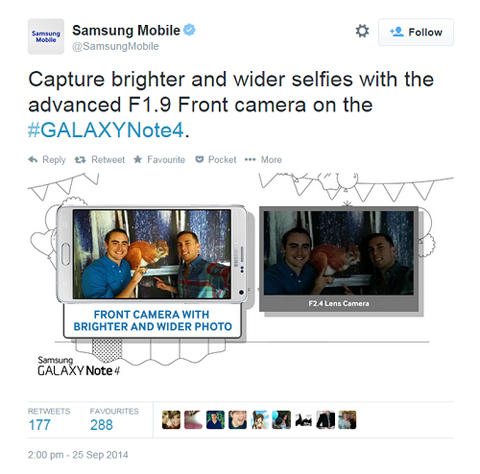
Anyone viewing the above image from Samsung would want to associate themselves with the newer camera and improved image, rather than the old one.
Key Takeaway: Use Twitter to link your products and services to the three primary groups that customers respond to: aspirational, associative and dissociative. This will promote higher engagement, as well as cultivate users who have an affinity for your brand.
#2: Use Image Psychology
Many marketing and advertising studies have been conducted to see what type of images have the highest conversion or click-through rates. In nearly all studies, an image of a person, particularly a close-up of his or her face, increased the success of the ad or the web page.
Apply this research to your Twitter strategy. Tweet images with faces. And be sure to have a nice headshot on your Twitter profile.
37 Signals conducted a test that looked at different variations of the Highrise home page to see which one converted the most visitors to paying customers. They found that a page where they included an image of a person created a 102.5% increase in signups.
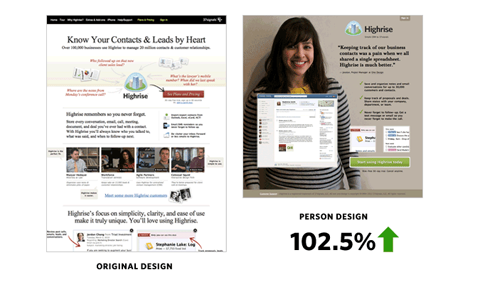
Jakob Nielsen, an expert in user interface design, explains that “a huge percentage of the human brain is dedicated to remembering and recognizing faces. For many, faces work better than names.”
To make your brand more recognizable to your Twitter audience, head up your profile image with the face of the company, such as the CEO or founder. This will make that person more recognizable to the audience, which is an especially important tactic for a new company.
Even for a SaaS company, where there is no obvious “person” to sell, it's useful to include images of happy customers within individual tweets, particularly those linking to blog posts or case studies. The effectiveness doesn't really come from who is in the image, it's more about what the image conveys to the reader.
Key Takeaway: Wherever possible, use an image in your profile picture to help users relate to the brand on a personal level. Also include images of users, customers or staff members within tweets and articles.

Discover Proven Marketing Strategies and Tips
Want to go even deeper with your marketing? Check out the Social Media Marketing Podcast! Publishing weekly since 2012, the Social Media Marketing Podcast helps you navigate the constantly changing marketing jungle, with expert interviews from marketing pros.
But don’t let the name fool you. This show is about a lot more than just social media marketing. With over 600 episodes and millions of downloads each year, this show has been a trusted source for marketers for well over a decade.
#3: Employ Self-Perception Theory
Self-perception theory is how people develop attitudes based on their own behavior. For example, if you go to a few baseball games, you'll probably decide that you're a baseball fan. Then, you'll act in a way that reinforces your identity as a baseball fan. You'll buy baseball memorabilia and/or engage in conversation with other baseball fans.
On Twitter users will retweet or favorite a tweet that they feel is consistent with their self-perception. For example, people who work in customer service or ecommerce would retweet or favorite the tweet below from KISSmetrics, because it fits in with how they perceive themselves and reinforces their identity on Twitter.
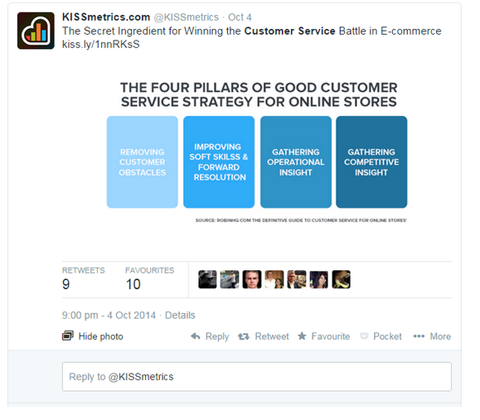
Key Takeaway: Determine how your customers identify themselves and create tweets that are consistent with that vision. For example, provide marketing tips for marketers or development resources and tools for developers. This type of tweet will increase engagement and sharing.
#4: Keep It Simple
If there's one thing all great advertisers know, it's to keep messages simple. The wonderful thing about Twitter is that you don't really have a choice. A message has to be succinct to make sense and still fit into 140 characters.
To increase engagement even more, try the short paragraph trick. Twitter allows you to create line breaks within your tweet, as shown below.
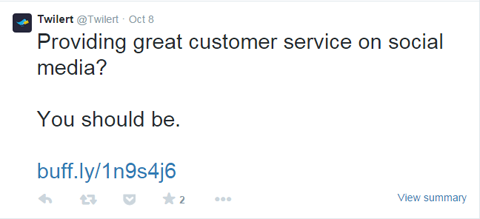
When you use short paragraphs, it moves your reader's eye down the page. This quickens the pace at which they read, makes your tweet look exciting and encourages a higher number of click-throughs to the article or image.
The short paragraph approach can also be used to create humor and show a more human side of your brand. Take a look at what General Electric did when Twitter first released line breaks.

Another simple trick is to repeat the language you use within your tweets to create a narrative that users can follow. Business-card designer Moo identified with and engaged users who have a side business through their hashtag campaign: #bynightiam.
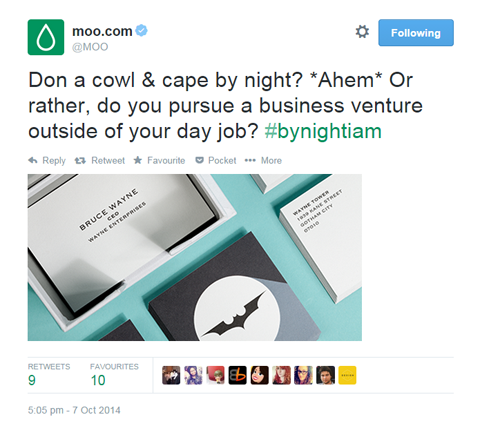
Key Takeaway: Use short paragraphs to build suspense and gain more click-throughs on your articles. Also, come up with hashtags or certain phrases and repeat them throughout a series of tweets or for a specific time span to increase brand recognition. One only needs to think of hashtags like #throwbackthursday and #flashbackfriday to see how well a campaign like this can work.
#5: Use Reverse Psychology
While big companies often try to tell customers what to do or think, some of the most successful advertisers are those who do the opposite through the form of reverse psychology.
HubSpot is one B2B brand that utilizes this trick when tweeting links to their blog posts such as the one below.

When you tell people not to read something, it's likely that many more will be enticed to click through, regardless of whether they fit the criteria told to read it or not. Note: Don't use this tactic too often or else you may be accused of click-baiting (giving the readers too little information in an attempt to get them to click).
Key Takeaway: When used sparingly, reverse psychology can be a great tactic to increase click-throughs and engage users.
#6: Use Initial Caps for Readability
According to a study by Conductor, when given a variety of ad headlines from which to choose, ranging from all caps to all lowercase to sentence case, 64% of users favored sentence case. (The study defines sentence case as where the first letter of each primary word is capitalized. It's commonly known as initial caps or title case.)
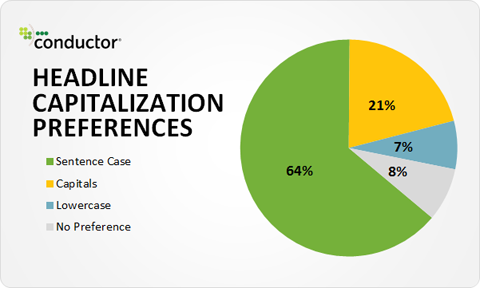
Buffer uses initial caps each time they send a tweet that promotes one of their blog articles, and it seems to work well for them.
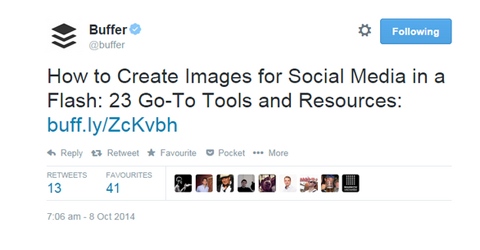
The use of initial caps is also said to increase reading speed, so a user needs less time to take in your tweet. This is backed by a series of studies by James Cattell, in which letter and word examples were given to study participants for a very brief amount of time (less than 10 milliseconds). From this, he found that the participants could accurately recognize the words more than the individual letters, a phenomenon he named the “word superiority effect.”
Key Takeaway: Use initial caps in your tweet, particularly if the tweet is promoting the headline of a blog article. This helps attract more readers and improves the speed at which your audience can digest the headline.
Conclusion
It's easy to always create the same type of tweets without thinking about why a user may click or retweet them. It's more effective to take the time to formulate a Twitter marketing strategy and create tweets that speak to your users.
What do you think? With what types of tweets do you get the best response? Have you used any advertising tricks to improve your tweets? What are your best Twitter tips? Comment below and let us know.
Attention Agency Owners, Brand Marketers, and Consultants

Introducing the Marketing Agency Show–our newest podcast designed to explore the struggles of agency marketers.
Join show host and agency owner, Brooke Sellas, as she interviews agency marketers and digs deep into their biggest challenges. Explore topics like navigating rough economic times, leveraging AI, service diversification, client acquisition, and much more.
Just pull up your favorite podcast app, search for Marketing Agency Show and start listening. Or click the button below for more information.


